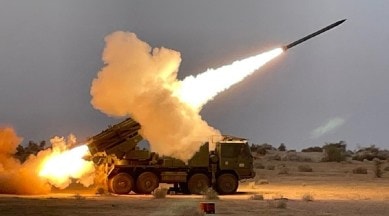IN a series of trials conducted over a span of three days, the Pinaka Extended Range (Pinaka-ER) missile and its ancillary systems developed by two Pune-based facilities of the Defence Research and Development Organisation (DRDO) were tested successfully last week. With these trials, the rocket system is now ready for series production by the industry partner, the Ministry of Defence has said. The Extended Range version of the Pinaka, which is primarily a multi barrel rocket launcher (MBRL) system, was tested along with its two ancillary systems — Area Denial Munitions (ADM) and indigenously developed fuzes — between Thursday and Saturday last week.
The Pinaka-ER MBRL was successfully tested at Pokhran range. These systems have been jointly designed and developed by Pune-based DRDO facilities —Armament Research and Development Establishment (ARDE) and High Energy Materials Research Laboratory (HEMRL). The Pinaka Mk-1, which has a range of 37.5 km, is currently in service of the Indian Army and multiple regiments of the system have been deployed in the past. Pinaka-ER, which is an upgraded version of the Pinaka Mk-1, has a range of 45 km and some additional features. The DRDO, after establishing the performance efficacy of Pinaka-ER, transferred the technology of the system to the industry. The industry partner has manufactured Pinaka-ER with DRDO’s help during the production and quality assurance processes. In continuation of the Transfer of Technology, rockets developed by the industry have undergone performance evaluation and quality certification process.
In the latest set of tests held over three days last week, the DRDO, along with the Army, conducted a series of performance evaluation trials of these industry-produced rockets at field firing ranges. In these trials, Pinaka-ER rockets were test-fired at different ranges with various warhead capabilities. All the trial objectives were met satisfactorily. As many as 24 rockets were fired for different ranges and different warhead capabilities to meet the objectives of accuracy and consistency, the DRDO said.
“With this, the initial phase of technology absorption of Pinaka-ER by the industry partner has successfully been completed, making the industry partner ready for series production of the rocket system,” read a press statement from the MoD.
As part of this set of trials, Area Denial Munition (ADM) designed by the ARDE for Pinaka and manufactured by the industry partners under technology transfer were successfully tested at Pokhran Field Firing Ranges. These trials are part of performance evaluation under technology absorption. ADMs are a category of ammunition used to prohibit the adversary from occupying or passing through a particular area. At the same time, indigenously-developed proximity fuzes for Pinaka rockets have also been tested. The ARDE has developed different fuzes for Pinaka rockets for different types of applications. After design validation trials, performance of these fuzes has been evaluated with flight testing.
The DRDO said these indigenously developed fuzes will replace the imported fuzes. The ARDE has also designed miniaturised fuzes for ADMs. During the same set of trials, the performance of dual-purpose Direct-Action Self Destruction (DASD) and Anti-Tank Munition (ATM) fuzes were evaluated and the results were satisfactory.
Commenting on the series of successful tests, ARDE Director Dr V Ventateshwara Rao said, “The performance of the Pinaka rocket system is testimony of DRDO directions towards Atmanirbhar Bharat. The system met all the mission objectives of range, accuracy and consistency. Our teams at ARDE, HEMRL, PXE (Proof and Experimental Establishment) are looking for export of MBRL systems. Congratulations to the entire team.”
Story continues below this ad
In the battlefield, long-range artillery systems like Pinaka are used for attacking the adversary targets prior to close quarter battles which involve smaller range artillery, armoured elements and the infantry.
The development of the Pinaka was started by the DRDO in the late 1980s, as an alternative to the multi barrel rocket launching systems of Russian make called like the ‘Grad’, which are still in use. After successful tests of Pinaka, it was first used in the battlefield during the Kargil war of 1999 quite successfully. Subsequently, multiple regiments of the system came up over the 2000s.
Pinaka MBRL can fire a salvo of 12 rockets over a period of 44 seconds. One battery of Pinaka system consists of six launch vehicles, accompanied by the loader systems, radar and links with network based systems and a command post. One battery can neutralise an area one km by one km. While Pinaka Mk-1 has a range of 37.5 km and Pinaka-ER of 45 km, the Pinaka Mk-II has a range of 60 km. The guided version of the Pinaka has also been developed and tested multiple times and has a range of 75 km. An extended range version of the Pinaka Mk-II and Pinaka Mk-III are also said to be under development.
